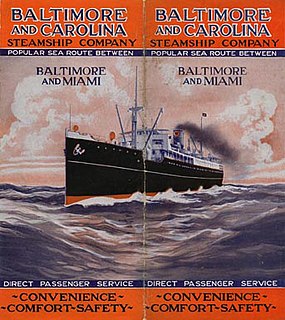
William Denny and Brothers Limited, often referred to simply as Denny, was a Scottish shipbuilding company.
William Hamilton and Company was a British shipyard in Port Glasgow, Scotland. The company was bought by Lithgow Ltd., which later became Scott Lithgow and was nationalised as part of British Shipbuilders in 1977.
A number of ships have been named Persia including

HMS Forfar (F30) was a British ocean liner that was commissioned into the Royal Navy as an armed merchant cruiser in 1939 and sunk by enemy action in 1940. She was launched in Scotland in 1920 as a transatlantic liner for the Canadian Pacific Steamship Company as Montrose. She was one of three sister ships. The others were Montcalm, also launched in 1920, and Montclare, launched in 1921.

SS Clan Fraser was a British cargo steamship. She served in the Second World War and was bombed and sunk in Greece in 1941.

The Cameron-class steamships were a class of UK cargo twin-screw steamships. They were designed for Clan Line and were also used by Scottish Shire Line and the Royal Navy.

The SS Clan Forbes was a British cargo steamship. She was built for Clan Line Steamers Ltd as one of its Cameron-class steamships. She was launched at Greenock in 1938, served in the Second World War and was scrapped in Hong Kong 1959.
SS Manistee was an Elders & Fyffes Ltd banana boat that was launched in 1920. She was one of a numerous class of similar banana boats built for Elders & Fyffes in the 1920s.

USS Howick Hall (ID-1303) was a cargo steamship that was built in Scotland in 1910 and served in the merchant fleets of the United Kingdom, United States, Italy and Panama. She briefly served in the United States Army in 1917–18 and then the United States Navy in 1918–19. The United States Maritime Commission bought her in 1941, and a German air attack sank her in 1942.

HMHS Lanfranc was a Booth Line passenger steamship that was built in Scotland in 1907 and operated scheduled services between Liverpool and Brazil until 1914. In the First World War she was a hospital ship until a U-boat sank her in the English Channel in 1917.
Alexander Hall and Sons was a shipbuilder that operated in Aberdeen from 1797 to 1957. They designed the pointed and sharply raked Aberdeen bow" first used on the Scottish Maid and which became a characteristic of the "extreme clippers".
Farrell Lines Incorporated was a boat company named in 1948 after James A. Farrell, Jr., and John J. Farrell, sons of James Augustine Farrell, president of US Steel. The company was previously known as American South African Lines (ASAL). It was a passenger line and cargo line in regular service from New York City to South Africa stopping at Cape Town, Port Elizabeth, Durban and Lourenço Marques (Maputo) in Mozambique. The ships were well-appointed and carried about 180 passengers.
SS Glenartney was a cargo steamship that was launched in Scotland in 1911 and sunk by a U-boat in the English Channel in 1918.
SS Jumna was a steam passenger liner that was built in Scotland in 1929 and sunk with all hands by a German cruiser on Christmas Day 1940. She was a ship in the fleet of James Nourse, Ltd, whose trade included taking indentured labourers from India to the British West Indies.
Glen Artney or Glenartney is a valley in Perthshire, Scotland.
SS Tregarthen was a cargo steamship that was built in Scotland for the Hain Steam Ship Co in 1936. She was sunk with all hands by a U-boat in 1941 in the Battle of the Atlantic.
SS Hartlebury was a cargo steamship that was launched in Scotland in 1934 for J&C Harrison Ltd. A U-boat sank her in the Barents Sea in 1942 when Hartlebury was a member of the Arctic convoy Convoy PQ 17.

Calmar Steamship Company was a proprietary subsidiary of the Bethlehem Steel founded in New York City in 1927. Bethlehem Steel Company founded Calmar Steamship Company and other steamship companies after finding general shipping companies could not meet the company's needs in a timely manner. At the time Bethlehem Steel Company was the second-largest steelmaker in the United States and the world, only behind U.S. Steel. Calmar Steamship Company shipped Bethlehem Steel Company products from the Atlantic coast to the Pacific coast. On the return trip, Calmar Steamship Company would bring lumber products from the Pacific coast to the Atlantic coast. Calmar Steamship Company closed in 1976, as United States steel manufacture declined in the 1960s.

A. H. Bull Steamship Company was a shipping company and passenger liner service founded in New York City in 1902 by Archibald H. Bull (1848-1920). Service started with shipping between New York and Florida. His fleet of ships then added service to other Eastcoast ports. The company is also often called the Bull Lines and the Bull Steamship Line or A. H. Bull & Company. While founded in New York, Bull soon move its headquarter to Peir 5 in Baltimore, Maryland. Bull Lines main Eastcoast ports were: Baltimore, Charleston, Philadelphia, Tampa and Norfolk, Virginia. Oversea ports: Porto Rico, Antwerp, Bordeaux, Hamburg, Bremen, Copenhagen, and West Africa. Bull Steamship Line supported the US war effort for both World War I and World War II, including the loss of ships.










